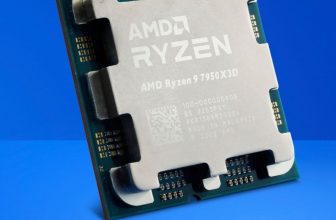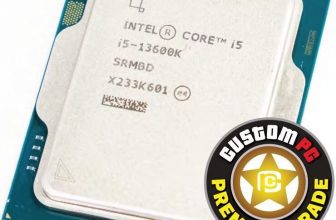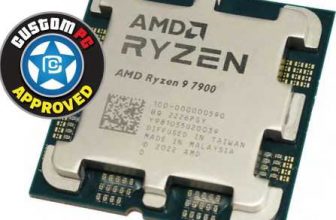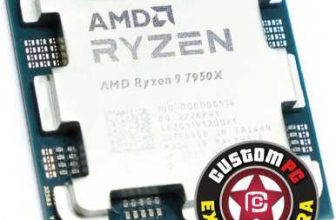Intel Core I7-7700K Review: How good are the eighth-generation waters?
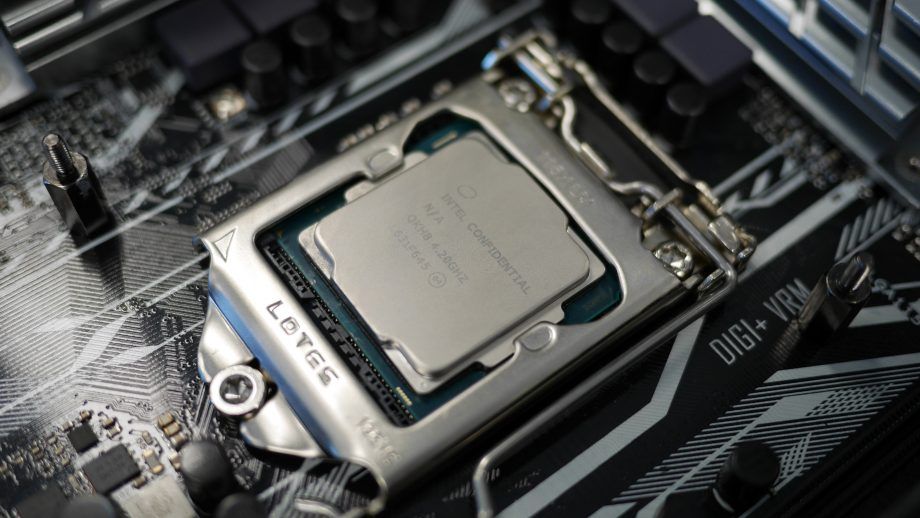
Intel Core I7-7700K Review – Zak Storey dips his toe in Kaby Lake to find out.

Table of Contents
Intel Core I7-7700K Review: In brief…
» Socket 1151 » Cache: 8MB » Type: 64-bit » SSE: 4.1/4.2. AVX 2.0 » Process: 14nm » Cores: 4 » Threads: 8 » Clock: 4.2GHz » Turbo: 4.5GHz » TDP: 91W » Max memory: 64GB DDR4 » Channels: 2 » GPU: Intel HD Graphics 630 » Clock: 350MHz » Max: L15GHz » Units: 24 » OpenGL: 4.4 » Displays: 3 » Virtual tech: VT-x,VT-d
Kaby lake is eighth processor iteration since the introduction of the Intel Core series that started with Nehalem. For eight years, the company has pressed to push the advantage in its processor lineup, and each and every time it’s managed a marginal 10-15 percent performance increase. This process has been, for the longest time, based around the concept of Tick-Tock. In short, a new architecture would be designed based on the latest transistor size, then that transistor size would be shrunk the following year. For instance, Sandy Bridge (or the Core i5-2500K) held the new architecture, while Ivy Bridge (Core i5-3570K), released a year later, was the die shrink, and so on.
i7-7700K is an overclocker’s dream.
However, this hasn’t always been the case, and Intel has, time and time again, come up against issues. The first we saw of this was with the Haswell refresh, known as Devil’s Canyon, then once more as Broadwell was delayed for around six months—each drop in transistor size becoming ever more difficult for the technology giant to achieve. Fast-forward to the release of Skylake, Intel’s first Unm architecture, and we’re greeted with news that Tick-Tock is finally being annexed in favor of a new scheme called PAO, or Process, Architecture, Optimization. In short, the die shrink (originally the Tick] has turned into the Process part; the architecture (the Tock) is now, well, the Architecture; and lastly we also have Optimization. A new piece to the puzzle, where Intel attempts to gain the maximum amount of performance possible from both a mature manufacturing process and a more optimized architecture. On top of giving Intel an additional year to perfect its manufacturing processes, it also gives us another chip.
Ignoring Devil’s Canyon, Kaby Lake is the first true Optimization release we’ve seen, and with it comes a lot of questions. If Intel’s generational gains have been so minimal from generation to generation, what on earth can Kaby Lake do to make that any different? Well, that’s what we re here to answer.
Intel Core I7-7700K Review: BENCHMARK BONANZA
Intel’s Core i7-7700K is a four-core, eight-threaded, low-power rendering powerhouse. It is, in short, the pinnacle of what Intel has managed to achieve with Skylake and the Unm technology. With greater performance and better overclocking potential than we’ve seen from any of Intel’s last few generations of chips, it comes packing a whopping 4.2GHz core frequency, turboing up to 4.5GHz with boost. We were immediately impressed with its out-of-box performance. In Cinebench R15, we saw scores planted well into the high 900s, with single-core performance peaking at 194—a sweet little 8 percent increase over Skylake. It was a similar experience across the board.
What really impressed, however, was the overclocking potential. We increased the multiplier up to 48 without the core batting so much as an eyelid, and stock voltages happily keeping the 4.8GHz chip on track. 5GHz came next, needing only a 0.05V increase to the Vcore, with temperatures sitting comfortably at 62 c under our 280mm NZXT Kraken X61. But it kept going, higher and higher, until eventually we topped out at 5.2GHz with 1.4V added to the Vcore—a substantial increase, but temperatures still only sitting at 80 c. This chip runs cool—ice cool, in fact. Stunningly impressive compared to older editions, this is an overclocker’s core.
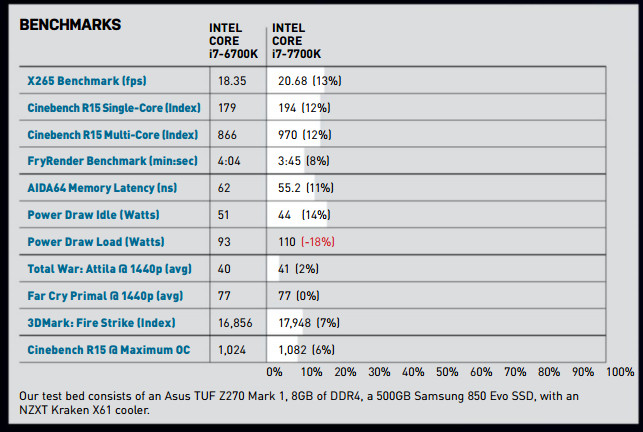
Is it worth upgrading today? Well, that depends on what interests you. Generally speaking, the Z270 chipset is feature-rich, and adds additional support for PCIe devices and such. But in contrast to the change from Z97 to Z170, it pales in comparison. Putting the processors side by side, the difference between Skylake and Kaby Lake is minimal. If you’re already set up with the sixth generation of processor, it’s certainly not worth your time, unless you’re an overclocking fiend after the highest possible performance, with lower temps, and better power draws. Upgrading from Ivy Bridge, Haswell, or Devil’s Canyon, on the other hand, is very much worth your time. And we can’t recommend this core enough in that regard.
ZAK STOREY
Kaby Lake is the eighth processor iteration since the introduction of the Intel Core series that started with Nehalem. For eight years, the company has pressed to push the advantage in its processor lineup, and each and every time it’s managed a marginal 10-15 per cent performance increase. This process has been based around the concept of Tick-Tock. A new architecture would be designed based on the latest transistor size, then that transistor size would be shrunk the following year. For instance. Sandy Bridge (or the Core i5-2500K) held the new architecture, while Ivy Bridge (Core i5-3570K), released a year later, was the die shrink, and so on.
However, time and time again. Intel has come up against issues. The first we saw of this was with the Haswell refresh, known as Devil’s Canyon, then once more as Broadwell was delayed for six months – each drop in transistor size becoming ever more difficult to achieve. Fast-forward to the release of Skylake. Intel’s first 14nm architecture, and we’re greeted with news that Tick-Tock is being annexed in favour of a new scheme called PAO, or Process. Architecture. Optimisation. In short, the die shrink (the Tick) turned into the Process: the architecture (the Tock) is now, well, the Architecture: and lastly we have Optimisation. A new piece to the puzzle, where Intel tries to gain the maximum performance possible from a mature manufacturing process and a more optimised architecture. On top of giving Intel an extra year to perfect its processes, it also gives us another chip.
Ignoring Devil’s Canyon. Kaby Lake is the first true Optimisation release, and with it comes a lot of questions. If Intel’s generational gains have been so minimal, what can Kaby Lake do to make that any different? Well, that’s what we’re here to answer.
Intel’s Core i7-7700K is a four-core. eight-threaded. low-power rendering powerhouse. The pinnacle of what Intel has managed to achieve with Skylake and the 14nm technology.
With greater performance and better overclocking potential than we’ve seen from any of Intel’s last few generations, it comes packing a whopping 4.2GHz core frequency, turboing up to 4.5GHz with boost. We were immediately impressed with its out-of-box performance. In Cinebench R15 (via Wine), we saw scores well into the high 900s. with single-core performance peaking at 194 – a sweet 8 per cent increase over Skylake. It was a similar experience across the board.
What really impressed, though, was its overclocking potential. We increased the multiplier to 48 without the core batting an eyelid, and stock voltages happily keeping the 4.8GHz chip on track. 5GHz came next, needing only a 0.05V increase to the Vcore, with temperatures sitting comfortably at 62° C under our 280mm NZXT Kraken X61. But it kept going, higher and higher, until we topped out at 5.2GHz with 1.4V added to the Vcore – a substantial increase, but temperatures still only sitting at 80° C.
Is it worth upgrading today? Well, that depends on what interests you. Generally speaking, the Z270 chipset is feature-rich, and adds additional support for PCIe devices and such. But it pales in comparison to the change from Z97 to Z170. Putting them side by side, the difference between Skylake and Kaby Lake is minimal. If you’re already set up with the sixth generation of processor, it’s not worth your time: upgrading from Ivy Bridge, Haswell, or Devil’s Canyon, on the other hand, very much is. And we can’t recommend this core enough in that regard.
Intel Core I7-7700K Review: Verdict
» You might want to hold off until our Ryzen review, but this is a solid buy with excellent overclocking abilities.
When you purchase through links on our site, I may earn an affiliate commission. Here’s how it works.





